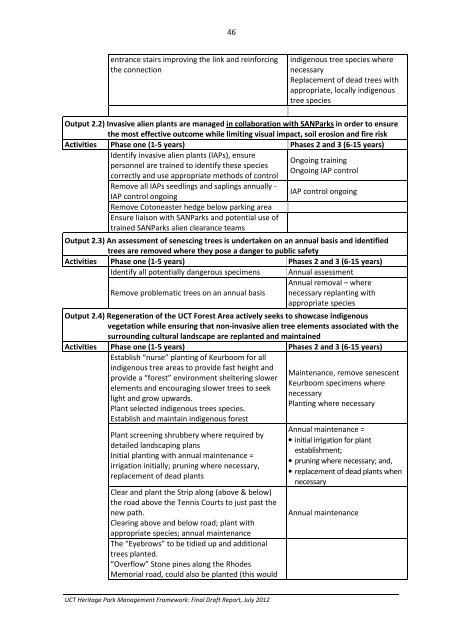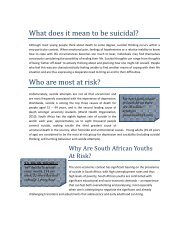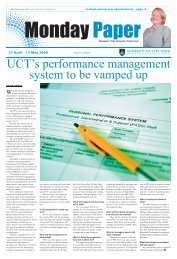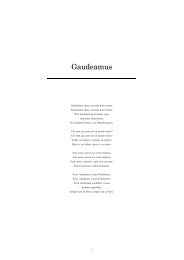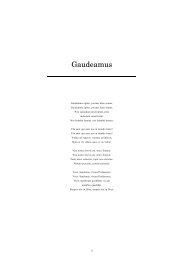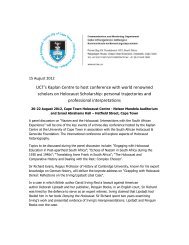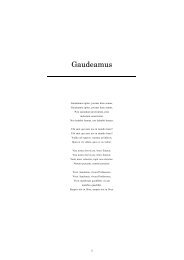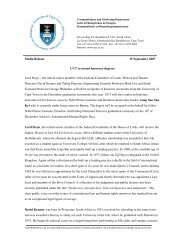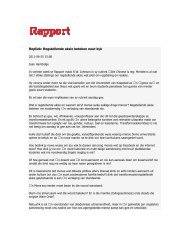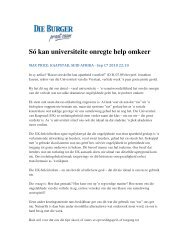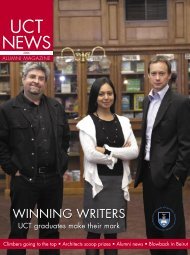uct heritage park management framework - University of Cape Town
uct heritage park management framework - University of Cape Town
uct heritage park management framework - University of Cape Town
You also want an ePaper? Increase the reach of your titles
YUMPU automatically turns print PDFs into web optimized ePapers that Google loves.
46<br />
entrance stairs improving the link and reinforcing<br />
the connection<br />
UCT Heritage Park Management Framework: Final Draft Report, July 2012<br />
indigenous tree species where<br />
necessary<br />
Replacement <strong>of</strong> dead trees with<br />
appropriate, locally indigenous<br />
tree species<br />
Output 2.2) Invasive alien plants are managed in collaboration with SANParks in order to ensure<br />
the most effective outcome while limiting visual impact, soil erosion and fire risk<br />
Activities Phase one (1-5 years) Phases 2 and 3 (6-15 years)<br />
Identify invasive alien plants (IAPs), ensure<br />
personnel are trained to identify these species<br />
correctly and use appropriate methods <strong>of</strong> control<br />
Remove all IAPs seedlings and saplings annually -<br />
IAP control ongoing<br />
Remove Cotoneaster hedge below <strong>park</strong>ing area<br />
Ensure liaison with SANParks and potential use <strong>of</strong><br />
trained SANParks alien clearance teams<br />
Ongoing training<br />
Ongoing IAP control<br />
IAP control ongoing<br />
Output 2.3) An assessment <strong>of</strong> senescing trees is undertaken on an annual basis and identified<br />
trees are removed where they pose a danger to public safety<br />
Activities Phase one (1-5 years) Phases 2 and 3 (6-15 years)<br />
Identify all potentially dangerous specimens Annual assessment<br />
Remove problematic trees on an annual basis<br />
Annual removal – where<br />
necessary replanting with<br />
appropriate species<br />
Output 2.4) Regeneration <strong>of</strong> the UCT Forest Area actively seeks to showcase indigenous<br />
vegetation while ensuring that non-invasive alien tree elements associated with the<br />
surrounding cultural landscape are replanted and maintained<br />
Activities Phase one (1-5 years) Phases 2 and 3 (6-15 years)<br />
Establish “nurse” planting <strong>of</strong> Keurboom for all<br />
indigenous tree areas to provide fast height and<br />
provide a “forest” environment sheltering slower<br />
elements and encouraging slower trees to seek<br />
light and grow upwards.<br />
Plant selected indigenous trees species.<br />
Establish and maintain indigenous forest<br />
Plant screening shrubbery where required by<br />
detailed landscaping plans<br />
Initial planting with annual maintenance =<br />
irrigation initially; pruning where necessary,<br />
replacement <strong>of</strong> dead plants<br />
Clear and plant the Strip along (above & below)<br />
the road above the Tennis Courts to just past the<br />
new path.<br />
Clearing above and below road; plant with<br />
appropriate species; annual maintenance<br />
The “Eyebrows” to be tidied up and additional<br />
trees planted.<br />
“Overflow” Stone pines along the Rhodes<br />
Memorial road, could also be planted (this would<br />
Maintenance, remove senescent<br />
Keurboom specimens where<br />
necessary<br />
Planting where necessary<br />
Annual maintenance =<br />
• initial irrigation for plant<br />
establishment;<br />
• pruning where necessary; and,<br />
• replacement <strong>of</strong> dead plants when<br />
necessary<br />
Annual maintenance


